Abstract
Midpoint potentials of plant-type ferredoxins from a range of sources were measured by redox titrations combined with electron-paramagnetic-resonance spectroscopy. For ferredoxins from higher plants, green algae and most red algae, the midpoint potentials (at pH 8.0) were between --390 and --425 mV. Values for the major ferredoxin fractions from blue-green algae were less negative (between --325 and --390 mV). In addition, Spirulina maxima and Nostoc strain MAC contain second minor ferredoxin components with a different potential, --305 mV (the highest so far measured for a plant-algal ferrodoxin) for Spirulina ferrodoxin II, and --455 mV (the lowest so far measured for a plant-algal ferredoxin) for Nostoc strain MAC ferredoxin II. However, two ferredoxins extracted from a variety of the higher plant Pisum sativum (pea) had midpoint potentials that were only slightly different from each other. These values are discussed in terms of possible roles for the ferredoxins in addition to their involvement in photosynthetic electron transport.
Full text
PDF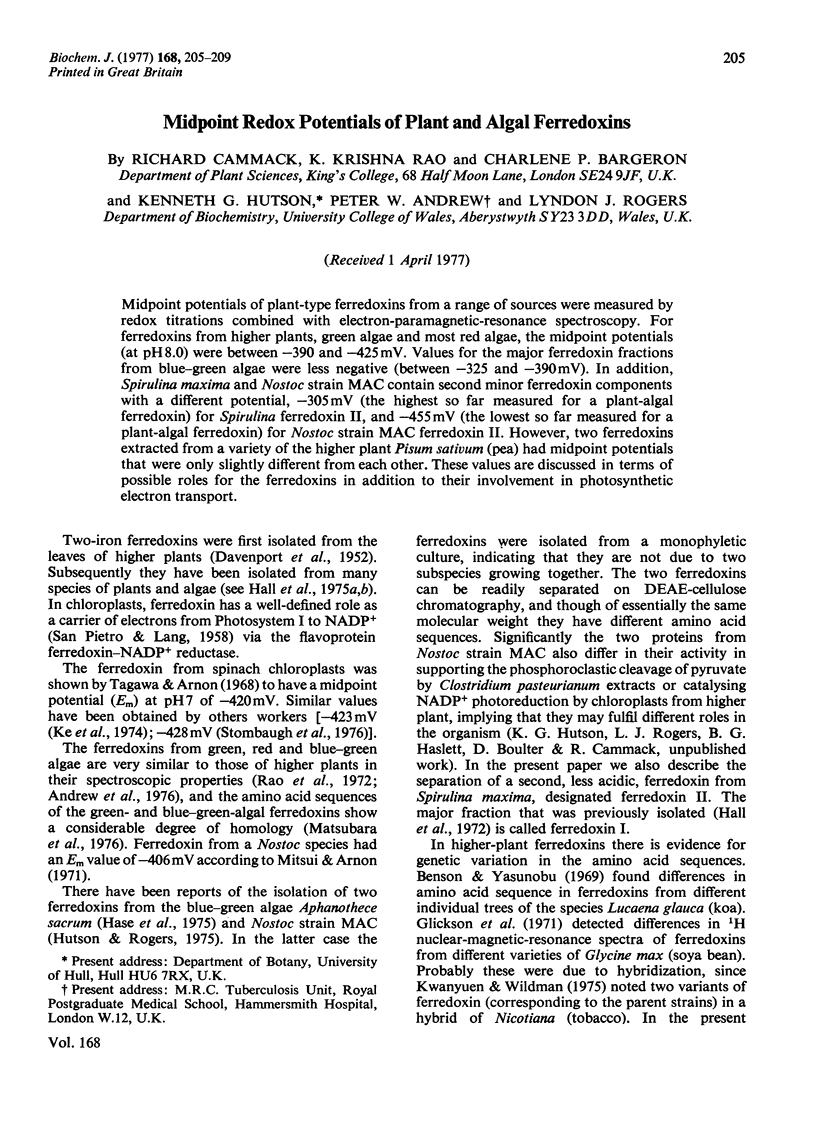
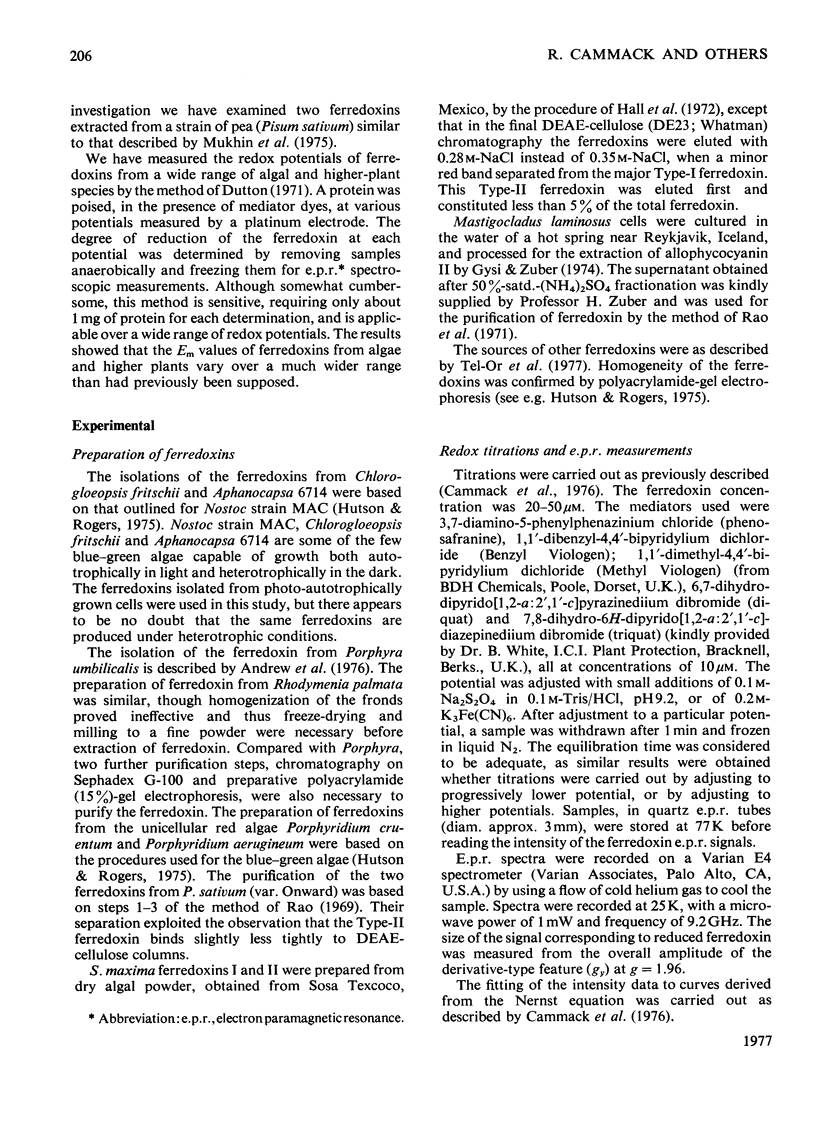
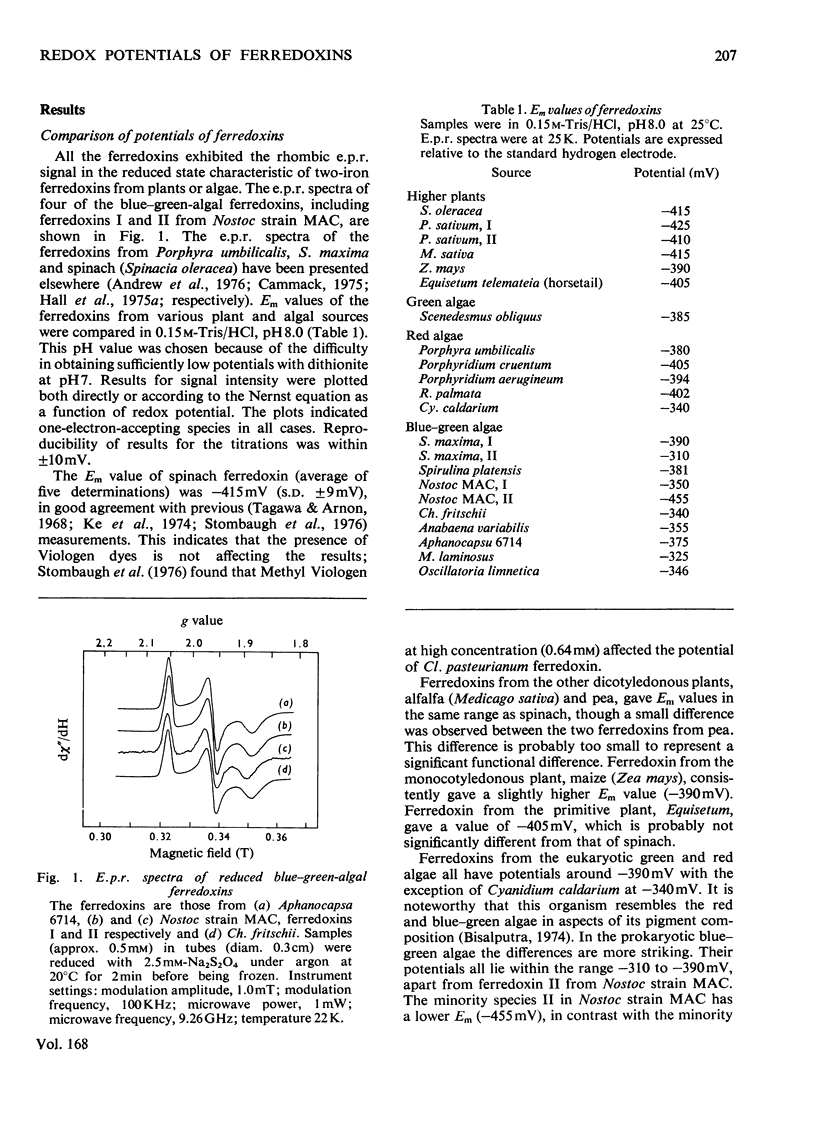
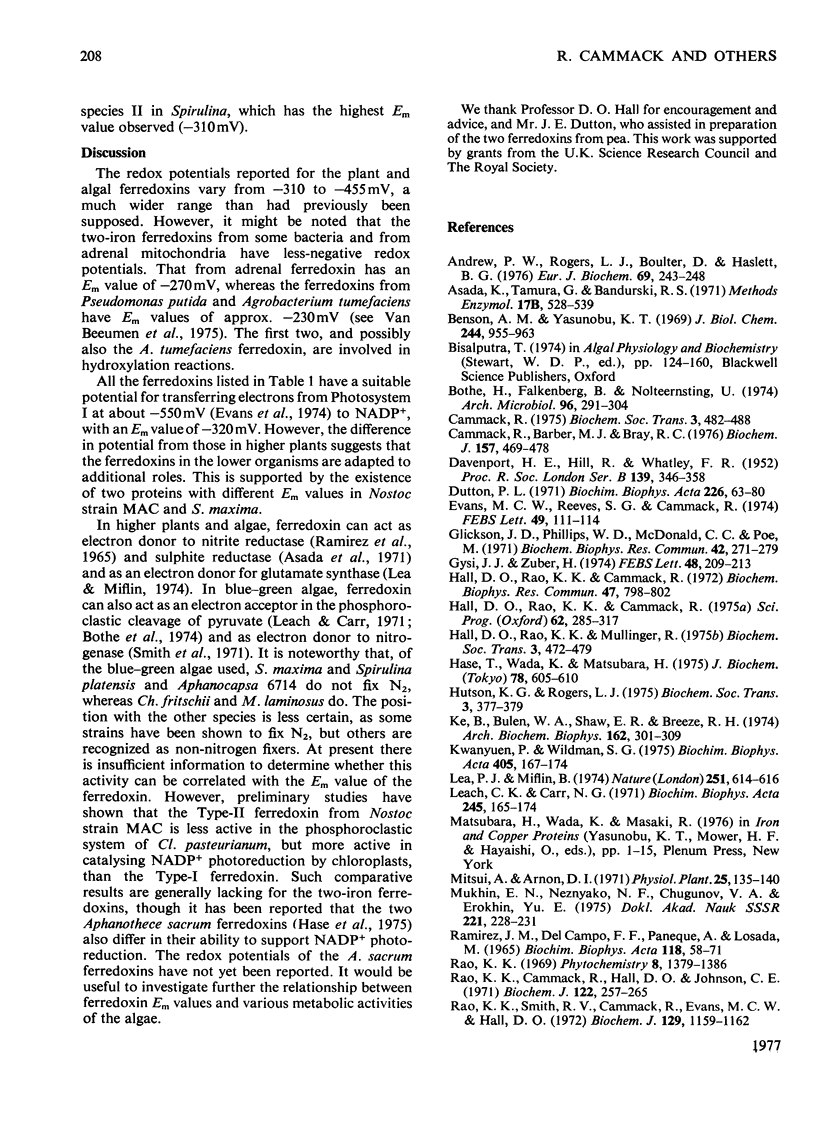
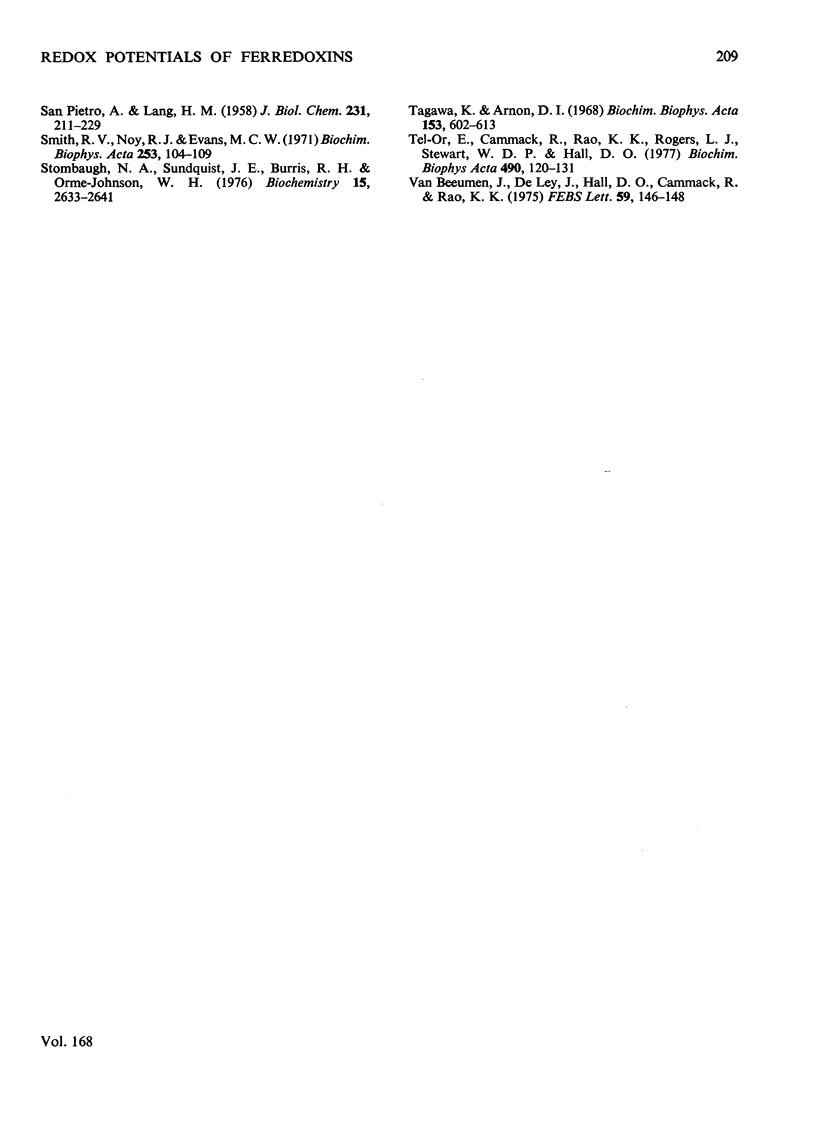
Selected References
These references are in PubMed. This may not be the complete list of references from this article.
- Andrew P. W., Rogers L. J., Boulter D., Haslett B. G. Ferredoxin from a red alga, Porphyra umbilicalis. Eur J Biochem. 1976 Oct 1;69(1):243–248. doi: 10.1111/j.1432-1033.1976.tb10879.x. [DOI] [PubMed] [Google Scholar]
- Benson A. M., Yasunobu K. T. Non-heme iron proteins. X. The amino acid sequences of ferredoxins from Leucaena glauca. J Biol Chem. 1969 Feb 10;244(3):955–963. [PubMed] [Google Scholar]
- Bothe H., Falkenberg B., Nolteernsting U. Properties and function of the pyruvate: ferredoxin oxidoreductase from the blue-green alga Anabaena cylindrica. Arch Mikrobiol. 1974 Mar 28;96(4):291–304. doi: 10.1007/BF00590185. [DOI] [PubMed] [Google Scholar]
- Cammack R., Barber M. J., Bray R. C. Oxidation-reduction potentials of molybdenum, flavin and iron-sulphur centres in milk xanthine oxidase. Biochem J. 1976 Aug 1;157(2):469–478. doi: 10.1042/bj1570469. [DOI] [PMC free article] [PubMed] [Google Scholar]
- Cammack R. Effects of solvent on the properties of ferredoxins. Biochem Soc Trans. 1975;3(4):482–488. doi: 10.1042/bst0030482. [DOI] [PubMed] [Google Scholar]
- DAVENPORT H. E., HILL R., WHATLEY F. R. A natural factor catalyzing reduction of methaemoglobin by isolated chloroplasts. Proc R Soc Lond B Biol Sci. 1952 Apr 24;139(896):346–358. doi: 10.1098/rspb.1952.0017. [DOI] [PubMed] [Google Scholar]
- Dutton P. L. Oxidation-reduction potential dependence of the interaction of cytochromes, bacteriochlorophyll and carotenoids at 77 degrees K in chromatophores of Chromatium D and Rhodopseudomonas gelatinosa. Biochim Biophys Acta. 1971 Jan 12;226(1):63–80. doi: 10.1016/0005-2728(71)90178-2. [DOI] [PubMed] [Google Scholar]
- Evans M. C., Reeves S. G., Cammack R. Determination of the oxidation-reduction potential of the bound iron-sulphur proteins of the primary electron acceptor complex of photosystem I in spinach chloroplasts. FEBS Lett. 1974 Dec 1;49(1):111–114. doi: 10.1016/0014-5793(74)80644-7. [DOI] [PubMed] [Google Scholar]
- Glickson J. D., Phillips W. D., McDonald C. C., Poe M. PMR characterization of alfalfa and soybean ferredoxins: the existence of two ferredoxins in soybean. Biochem Biophys Res Commun. 1971 Jan 22;42(2):271–279. doi: 10.1016/0006-291x(71)90098-2. [DOI] [PubMed] [Google Scholar]
- Gysi J., Zuber H. Isolation and characterization of allophycocyanin II from the thermophilic blue-green alga Mastigocladus laminosus Cohn. FEBS Lett. 1974 Nov 15;48(2):209–213. doi: 10.1016/0014-5793(74)80469-2. [DOI] [PubMed] [Google Scholar]
- Hall D. O., Rao K. K., Cammack R. A stable and easily extractable plant-type ferredoxin from the blue-green alga Spirulina maxima. Biochem Biophys Res Commun. 1972 May 26;47(4):798–802. doi: 10.1016/0006-291x(72)90562-1. [DOI] [PubMed] [Google Scholar]
- Hall D. O., Rao K. K., Cammack R. The iron-sulphur proteins: structure, function and evolution of a ubiquitous group of proteins. Sci Prog. 1975 Summer;62(246):285–317. [PubMed] [Google Scholar]
- Hall D. O., Rao K. K., Mullinger R. Biological functions of iron-sulphur proteins. Biochem Soc Trans. 1975;3(4):472–479. doi: 10.1042/bst0030472. [DOI] [PubMed] [Google Scholar]
- Hase T., Wada K., Matsubara H. A minor component of ferredoxin from Aphanothece sacrum cells. J Biochem. 1975 Sep;78(3):605–610. doi: 10.1093/oxfordjournals.jbchem.a130946. [DOI] [PubMed] [Google Scholar]
- Hutson K. G., Rogers L. J. Two plant-type ferredoxins in light-grown and dark-grown cells of the blue-green bacterium Nostoc strain MAC. Biochem Soc Trans. 1975;3(3):377–379. doi: 10.1042/bst0030377. [DOI] [PubMed] [Google Scholar]
- Ke B., Bulen W. A., Shaw E. R., Breeze R. H. Determination of oxidation-reduction potentials by spectropolarimetric titration: application to several iron-sulfur proteins. Arch Biochem Biophys. 1974 May;162(1):301–309. doi: 10.1016/0003-9861(74)90129-5. [DOI] [PubMed] [Google Scholar]
- Kwanyuen P., Wildman S. G. Nuclear DNA codes for Nicotiana ferredoxin. Biochim Biophys Acta. 1975 Sep 9;405(1):167–174. doi: 10.1016/0005-2795(75)90327-x. [DOI] [PubMed] [Google Scholar]
- Lea P. J., Miflin B. J. Alternative route for nitrogen assimilation in higher plants. Nature. 1974 Oct 18;251(5476):614–616. doi: 10.1038/251614a0. [DOI] [PubMed] [Google Scholar]
- Leach C. K., Carr N. G. Pyruvate: ferredoxin oxidoreductase and its activation by ATP in the blue-green alga Anabaena variabilis. Biochim Biophys Acta. 1971 Aug 6;245(1):165–174. doi: 10.1016/0005-2728(71)90019-3. [DOI] [PubMed] [Google Scholar]
- Ramírez J. M., Del Campo F. F., Paneque A., Losada M. Ferredoxin-nitrite reductase from spinach. Biochim Biophys Acta. 1966 Apr 12;118(1):58–71. doi: 10.1016/s0926-6593(66)80144-3. [DOI] [PubMed] [Google Scholar]
- Rao K. K., Cammack R., Hall D. O., Johnson C. E. Mössbauer effect in Scenedesmus and spinach ferredoxins. The mechanism of electron transfer in plant-type iron-sulphur proteins. Biochem J. 1971 Apr;122(3):257–265. doi: 10.1042/bj1220257. [DOI] [PMC free article] [PubMed] [Google Scholar]
- Rao K. K., Smith R. V., Cammack R., Evans M. C., Hall D. O. Spectroscopic characterization of ferredoxin from the blue-green alga Microcystis flos-aquae. Biochem J. 1972 Oct;129(5):1159–1162. doi: 10.1042/bj1291159. [DOI] [PMC free article] [PubMed] [Google Scholar]
- SAN PIETRO A., LANG H. M. Photosynthetic pyridine nucleotide reductase. I. Partial purification and properties of the enzyme from spinach. J Biol Chem. 1958 Mar;231(1):211–229. [PubMed] [Google Scholar]
- Smith R. V., Noy R. J., Evans M. C. Physiological electron donor systems to the nitrogenase of the blue-green alga Anabaena cylindrica. Biochim Biophys Acta. 1971 Nov 2;253(1):104–109. doi: 10.1016/0005-2728(71)90238-6. [DOI] [PubMed] [Google Scholar]
- Stombaugh N. A., Sundquist J. E., Burris R. H., Orme-Johnson W. H. Oxidation-reduction properties of several low potential iron-sulfur proteins and of methylviologen. Biochemistry. 1976 Jun 15;15(12):2633–2641. doi: 10.1021/bi00657a024. [DOI] [PubMed] [Google Scholar]
- Tagawa K., Arnon D. I. Oxidation-reduction potentials and stoichiometry of electron transfer in ferredoxins. Biochim Biophys Acta. 1968 Apr 2;153(3):602–613. doi: 10.1016/0005-2728(68)90188-6. [DOI] [PubMed] [Google Scholar]
- Tel-Or E., Cammack R., Rao K. K., Rogers L. J., Stewart W. D., Hall D. O. Comparative immunochemistry of bacterial, algal and plant ferredoxins. Biochim Biophys Acta. 1977 Jan 25;490(1):120–131. doi: 10.1016/0005-2795(77)90112-x. [DOI] [PubMed] [Google Scholar]
- van Beeumen J., de Ley J. A ferrodoxin from Agrobacterium tumefaciens. FEBS Lett. 1975 Nov 15;59(2):146–148. doi: 10.1016/0014-5793(75)80362-0. [DOI] [PubMed] [Google Scholar]


